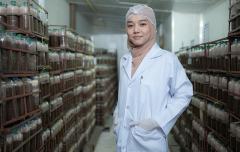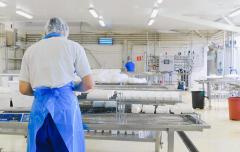Chilling Prospects Data Story: Sustainable Cooling in Schools
The Challenge
The world is experiencing an alarming rise in extreme heat, with children among the most vulnerable to its effects.Global temperatures are increasing, and annual averages are now regularly breaching critical climate thresholds. Heatwaves are becoming more frequent, longer in duration, and more intense, often affecting larger geographic areas than in the past. A UNICEF report found that 559 million children are already exposed to an average of 4.5 or more heatwaves each year. By 2050, that number is expected to reach 2 billion, even if warming is limited to 1.7°C. As climate change accelerates, the intensification of extreme heat events will pose a growing challenge for education systems, infrastructure, and social resilience worldwide.
Figure 1: Number of children exposed to 4.5 heatwaves per year
Rising temperatures are already disrupting education. School-level assessments point to multiple challenges linked to heat stress, including skin rashes, excessive sleepiness (‘slumbering’), and reduced concentration among students. In India, 10 extra hot days (above 29°C) reduces math and reading scores on tests by at least 0.03 and 0.02 standard deviations (SD) respectively across the whole ability spectrum, and a 1°C increase in temperature above 23 °C on exam days reduces test performance in math by 0.17 SD. By the end of the century, the number of hot days in India expected to double to 100, leading to a learning loss equivalent to more than two years of schooling.
Children in hot countries tend to perform worse at school. An International assessment found that a 0.56 °C increase in average annual temperature was associated with 0.02 SD lower score in the 2012 Programme for International Student Assessment (PISA) math test, showing the impact of heat on educational performance.
These impacts will only be exacerbated by more frequent and Intense heat waves. During an April 2024 heatwave In Asia and North Africa, students struggled to learn as temperatures exceeded an estimated 40°C, with more than 40 million children having their education disrupted as a result of heat-Induced school closures, and over 115 million students affected overall.
Figure 2: Impact of the April 2024 Heatwave in Asia and North Africa on Education
Activities typically conducted indoors, such as classroom learning or staff responsibilities, are often forced outdoors due to high temperatures, creating further disruptions. Schools relying on wells report that water dries up more quickly, while students require more frequent hydration. High temperatures can also increase non-attendance and disciplinary problems in settings without air conditioning.
Many schools lack the infrastructure to cope with extreme heat. Gaps such as unreliable electricity, poor ventilation, and inadequate building materials are widespread across schools in lower-middle income countries. Even when energy access is reliable, retrofitting schools with air conditioning can result in unaffordable installation and operating costs, as well as intermittent access to maintenance services. According to the India Centre for Science and Environment, air conditioning in classrooms may reduce children's ability to adapt to higher temperatures and induce thermal shocks that create health Issues such as colds.
There is an urgent need for more sustainable, context-appropriate, and action-oriented approaches that protect students and teachers, strengthen local communities, match solutions to school needs, and support broader education, health, and climate goals.
The Opportunity
Investing in sustainable cooling for schools delivers a triple dividend: it protects health, improves education outcomes, and strengthens community resilience to climate change. Schools present a high-impact entry point, reaching millions of children each day, offering potential as community cooling hubs during heatwaves, and serving as platforms to demonstrate scalable, low-carbon solutions, beyond the schools.
A wide spectrum of solutions is available, from nature-based approaches like tree planting and water features, to passive designs such as cross-ventilation and cool roofs, to non-refrigerant and full active cooling technologies. This range allows interventions to be tailored to local needs, infrastructure, and budgets. For example, one study in a rural area near Hyderabad, India, found that the implementation of a cool roof on a school reduced the average classroom temperature by 2.1°C and peak temperature by 5°C relative to uncoated classrooms. In the hot and dry climate of Burkina Faso where nighttime temperatures are often more than 10°C below daytime temperatures, the Gando Primary School used a number of passive design and ventilation solutions to reduce learning temperatures. These includes opposing openings for cross ventilation in classrooms; louvred openings to provide secure nighttime ventilation as well as daytime shading; exposed thermal mass from its brick construction; and a raised and ventilated roof which reduces solar heat gain into the classroom.
Where passive cooling measures do not provide comfort for schools in hot climates or densely packed classrooms, circulating fans (ceiling, floor or wall mounted) that can provide significant relief in regions where there is reliable electricity. While fans do not lower a room's temperature, they allow occupants to feel cooler by increasing air movement, which enhances sweat evaporation and convective cooling. The cooling effect can be equivalent to the air temperature being reduced by 2.5°C (see Figure 4). Efficient units typically range from 50W to 80W and can offer up to a 50% reduction in power consumption compared to less efficient alternatives. Outdoor air supply or extract fans can provide cooling if it is cooler outside than inside and provide the benefit of fresh air. Systems can be ducted or mounted directly on external walls. Additionally, such systems (as well as nighttime natural ventilation) can be leveraged to assist nighttime cooling of thermal mass in suitable climates.
Figure 3: Cooling effect of fans (Credit: CBE Berkeley)
Behaviour and practice change also offers low-cost resilience to heat in schools. Retrofitting for operable windows or shading (e.g. shutters or blinds) improves thermal comfort by lowering temperatures and providing breezes as well offering control of the learning space, which improves perceived comfort. Furthermore, if windows can be left securely open at night then it may be possible to cool thermal mass if nighttime temperatures are low enough. The use of flexible spaces (such as outdoor learning zones) to take advantage of best available thermal comfort (and air quality, light quality, etc.) also allows occupants to adapt and enhance learning in periods of high indoor heat.
Existing toolkits offer a foundation for identifying, de-risking, and prioritizing sustainable cooling solutions in schools. Resources such as the This is Cool Solutions Toolkit, the Cool School Manual, and the Mission Efficiency Marketplace offer practical guidance for matching appropriate interventions to context. These solutions can then be paired with the right delivery partners, linking global manufacturers with local implementers, including youth-led innovators like the winners of the This is Cool Youth Challenge. When deployed strategically, school-based interventions can catalyze local market development, create jobs, and contribute to broader education, climate, and equity goals.
Strategic collaboration and cross-sector coordination can make sustainable cooling in schools a global reality.This will require the development of practical designs, market shaping, and delivery expertise. Partners such as the Cool Coalition, and Mission Efficiency can support bringing technical leadership to enable these efforts at scale. But first, Governments and development partners must recognize the challenge extreme heat poses to students and elevate sustainable cooling in schools as an adaptation and resilience priority.
Related content

Data analysis
16 Sep 2025

Data analysis
24 Jul 2025

Research
25 Nov 2025
News
29 Apr 2025
